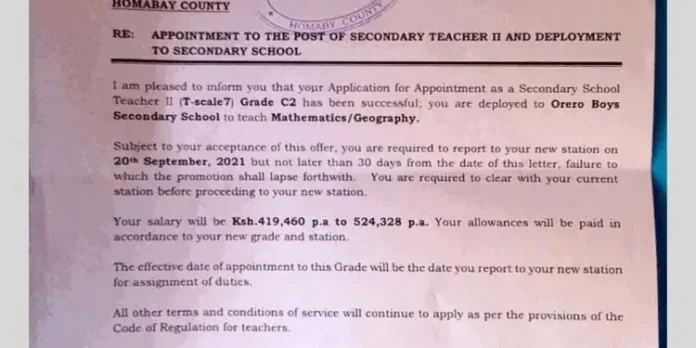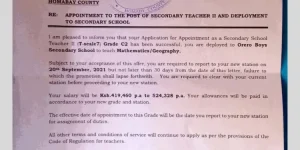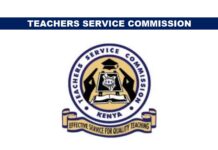
Shock As Primary Teachers Receive Deployment Letters Even Without Attending Interviews
Primary school teachers have started receiving employment letters in secondary schools as the Teachers Service Commission (TSC) introduces new changes.
Keep checking this article for changes, we are working to publish proof of distribution letters from teachers they received in July.
Also note that we are working on this article to establish the distributions made by TSC.
This is especially shocking as most P1 teachers are still waiting for official publicity for this year’s release from TSC. However it is an election year, anything is possible.
TSC plans to field practicing P1 teachers, who qualify to teach in secondary school, to teach in various secondary schools with vacancies.
The Commission started implementing this policy in 2019, where it employs 1,000 P1 teachers each year to teach in secondary schools.
Despite the discontinuation of automatic promotion of teachers who updated their certificates in January 2014, TSC still employs 1,000 PTE teachers each year to teach in secondary schools.
A total of 3,000 P1 graduate teachers have been promoted to teaching in secondary schools over the past three years.

TSC advertised 1,000 distribution seats in 2019 and another 1,000 in September 2020. The Commission advertised an additional 1,000 seats for distribution last year. However, the Commission has not made public through distribution announcements this year. Primary school teachers have been waiting for the announcement to start applying.
TSC was engaged in talks with officials from Kenya National Union of Teachers (Knut) last week from Wednesday to Friday
Knut, led by his Secretary General Collins Oyuu, was pushing the Commission to allow primary school teachers who have acquired an upper academic qualification through in-service training to teach in lower secondary school.
Knut specifically wanted the TSC to allow primary school teachers with a secondary option diploma but C (normal) in KCSE to be promoted to teach in those schools.
Knut also wants TSC to recognize PTE teachers with Diploma in secondary option during the distribution exercise.
Lower secondary school involves grades 7, 8 and 9. Current Grade 6 students will join the lower secondary school in January 2023.
TSC agreed to deploy primary school teachers to teach middle school, but on condition. TSC insists that teachers must meet the requirements for distribution in secondary schools.
According to TSC for teachers to be employed to teach in lower secondary school is necessary;
i) be a Kenyan citizen;
ii) hold a P1 Certificate;
iii) hold a Degree in Education with 2 teaching subjects;
iv) have obtained at least the average grade C + (Plus) in the Kenya Certificate of Secondary Education (KCSE) or equivalent and C + (Plus) or equivalent in the two teaching subjects;
v) Must serve at the Teachers’ Service Commission,
Commission data revealed that there were approximately 218,077 teachers in public primary schools in 2020.
21,632 teachers (9,821 males and 11,811 females) had bachelor’s degrees, while 17,930 teachers (8,627 males and 9,303 females) had three-year degrees.
About 491 teachers had masters and doctorates (197 male and 294 female) while the rest had certified qualifications.
There were approximately 113,155 teachers in Post Primary schools as of 2020. 1,725 teachers (909 male teachers and 816 female teachers) had masters and PhDs.
Those who have been employed from primary school to teach in secondary schools start in working group C2 and subsequently move on to working group C3 after completing the three years.
From July 2021 a teacher deployed in the C2 work group has brought home 34,955 shs as a minimum in basic pay and 43,694 shs at most.
The teacher has a commuter allowance of shs 5,000 a house allowance of shs 7,500 for those who are not in any municipality and a holiday allowance of shs 6,000 paid once a year. Those in disadvantaged areas enjoy a hardship allowance of shs 10,900.









